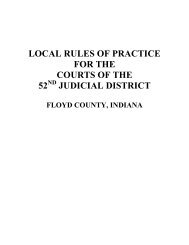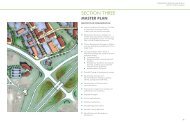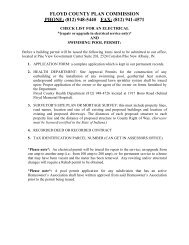Floyd County Thoroughfare Plan - Floyd County Indiana - State of ...
Floyd County Thoroughfare Plan - Floyd County Indiana - State of ...
Floyd County Thoroughfare Plan - Floyd County Indiana - State of ...
You also want an ePaper? Increase the reach of your titles
YUMPU automatically turns print PDFs into web optimized ePapers that Google loves.
<strong>Floyd</strong> <strong>County</strong>, <strong>Indiana</strong><strong>Floyd</strong> <strong>County</strong> <strong>Thoroughfare</strong> <strong>Plan</strong>Section 5–Implementation and Next Steps• Disadvantages- Fees may not cover the total infrastructure costs.- Improvement needs must be identified as well as the proposed solutions andimplementation costs. Continual long-term upkeep is required on various segregatedaccounts.- Fee revenues depend on the rate <strong>of</strong> development, and the amount <strong>of</strong> revenues collectedfrom year to year may fluctuate.C. Tax Incremental Financing (TIF)As part <strong>of</strong> the procedure for implementation <strong>of</strong> a Tax Incremental Financing District, a RedevelopmentCommission must be created. Any city, town, or county may establish a Department <strong>of</strong> Redevelopmentcontrolled by a board <strong>of</strong> five members. The five members <strong>of</strong> a county Redevelopment Commission areappointed by the <strong>County</strong> Commissioners.The Redevelopment Commission must utilize county personnel and/or outside consultants in order toprepare a Redevelopment <strong>Plan</strong>. The plan will provide evidence to support the findings that theRedevelopment Commission must make by statute, describe the redevelopment or economicdevelopment activities to be undertaken, and provide other information required by the <strong>State</strong> Tax BoardTIF regulations.After the Redevelopment <strong>Plan</strong> is completed, the Redevelopment Commission passes a DeclaratoryResolution which describes the blighted or economic development area, makes this area an allocationarea, adopts a plan <strong>of</strong> redevelopment for economic development, and makes required statutoryfindings. A “redevelopment area” must be a “blighted area”, which is defined as an area in which normaldevelopment and occupancy are undesirable or impossible because <strong>of</strong> any <strong>of</strong> a number <strong>of</strong> factors.The basic purpose <strong>of</strong> TIF is to provide for the allocation <strong>of</strong> increased tax proceeds generated byincreases in assessed value resulting from redevelopment within the TIF boundaries. TIF permits citiesto use increased tax revenues stimulated by redevelopment to pay for the capital improvements neededto induce the redevelopment. Redevelopment Commissions can exercise this power in “economicdevelopment areas,” the establishment <strong>of</strong> which does not require a finding <strong>of</strong> blight. Thus, TIF bondscan be issued to fund development activities in non-blighted areas the promote job opportunities.The advantages and disadvantages <strong>of</strong> Tax Incremental Financing are listed below.• Advantages- TIF makes the costs <strong>of</strong> infrastructure upgrades because <strong>of</strong> redevelopment self-financed.- TIF is highly flexible because no petition approval is necessary (unless, in the case <strong>of</strong> unitsother than <strong>Indiana</strong>polis, special taxes are to be levied in addition to the increment), there islocal control, and no debt limitation applies.- Shifts the risk <strong>of</strong> redevelopment from taxpayers to bondholders.Prepared by Strand Associates, Inc. ® 5-9KRH:pll\S:\@SIECO\001--050\046\008\Wrd\<strong>Thoroughfare</strong> <strong>Plan</strong>\Draft 07-19-07\S5-Implementation and Next Steps 07-19-07.doc\072007















